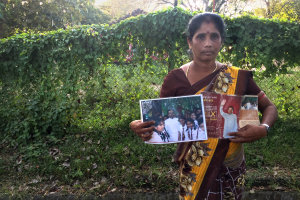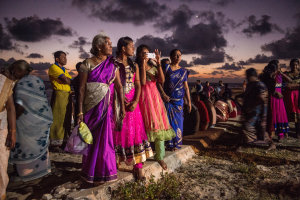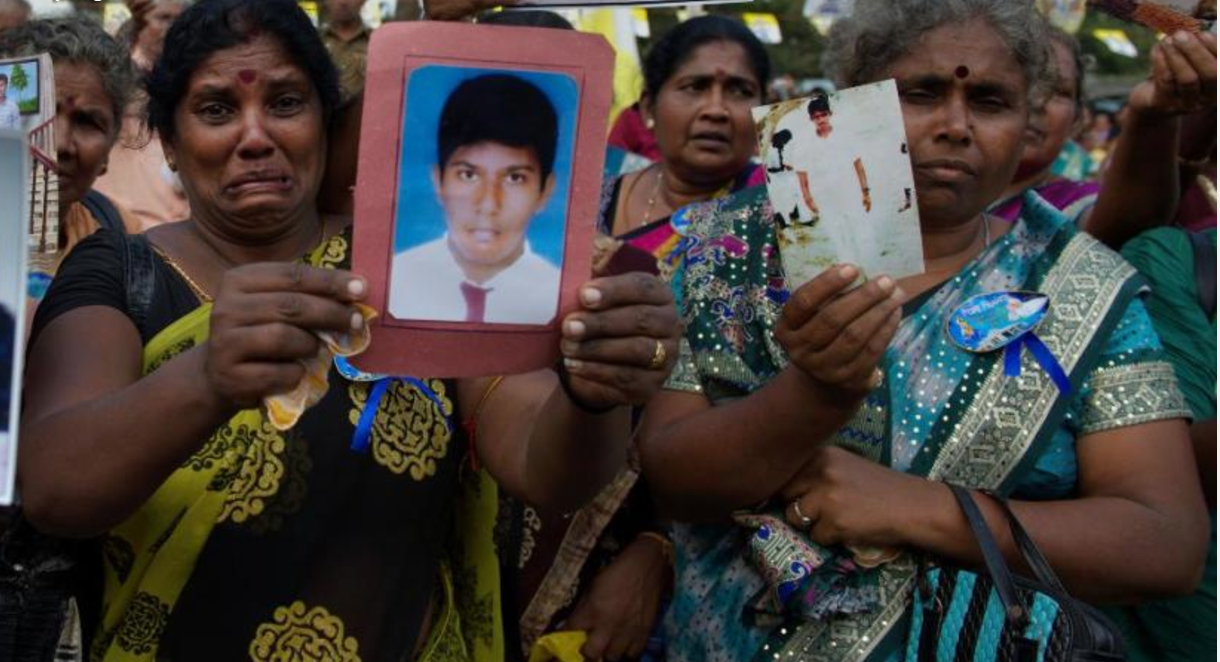By Devon Haynie .
VAVUNIYA, Sri Lanka — At some point during its brutal 26 years, the Sri Lankan civil war brought terror or loss to virtually everyone in the country. For Kasipillai Jeyavanitha, a mother of four, the defining moment of the conflict came in March 2009, just two months before the war ended eight years ago today.
She and her family were among thousands of civilians who had been living in the rebel-held territory, and who now found themselves trapped inside a conflict zone as the military made its final, terrifying advance on the group that had fought for her people’s independence.
Kasipillai and her 17-year-old daughter, Jeromy, were running toward safety during a shelling attack when a pickup truck approached. Several men wearing military uniforms jumped out of the truck and, without a word, threw both women in the back, where a group of frightened families huddled together.

“Let us jump now, I’d rather die on the road,” Kasipillai recalls Jeromy saying. Kasipillai told her not to worry, that nothing would happen in her presence. Minutes later, the men shoved Kasipillai and another mother from the truck. The last she saw of her daughter was her blurring face as the vehicle sped off in the sand.
Despite years of heartache, Kasipillai felt a tinge of optimism in 2015, when Sri Lankans elected a new president, Maithripala Sirisena, who promised a new kind of leadership. He committed to reform the economy, restore the rule of law, and heal the divided country, including taking steps to find out what happened to the tens of thousands of people who disappeared during the war.
But for Kasipillai and other Sri Lankans, the hopes born just over two years ago are rapidly fading. The tourism industry is booming, filling the teardrop-shaped island off India’s southern coast with Europeans headed to surf camps and elephant safaris, but most Sri Lankans have seen no improvement in their pocketbooks. Few people have been prosecuted for corruption. And eight years after the war’s end, grieving family members have still received no information about their missing loved ones, let alone justice for their disappearances.
Frustration is on the rise, and there’s a sense among many experts that if the government doesn’t change its course soon, the country could see the return of repressive leadership, and possibly – violent struggle.
Since late January, Kasipillai has spent her days sitting under a makeshift, open air shelter, holding a picture of Jeromy – thin, wide-eyed, and in pigtails. Along with 60 other women, Kasipillai’s on a rotating hunger strike to demand that the government disclose what happened to the country’s disappeared. It’s one of a growing number of protests – some over the missing, and some over military-occupied lands – that have popped up in recent months in the Vanni, the arid northern shrubland where the war’s bloody final battles took place.
Kasipillai and her fellow hunger strikers are all Tamil – part of Sri Lanka’s largest minority – who lost relatives in the war’s final months or in the few weeks after it ended. They talk of husbands snatched from their beds by security forces and brothers who disappeared while out for a quick errand. Most of the women sit silently during protests, holding dated images of their loved ones that sometimes double as fans in the oppressive heat.

Kasipillai’s face is virtually expressionless, almost stern. But when she talks about Jeromy, her brown eyes fill with tears. “I miss my daughter,” she says. “Not every day – every minute.” Kasipillai remembers Jeromy as a “jovial character,” an aspiring teacher who plans to help her family after school.
The descriptions are entirely in present tense. Like her fellow protesters, Kasipillai’s convinced the missing are still alive, held in secret government detention camps. But unlike the women sitting behind her, she carries something she believes justifies her intuition, at least when it comes to her daughter.
A Bloody History
It’s virtually impossible to know how many people have disappeared in Sri Lanka since the start of the war, but Amnesty International estimates the number could be as high as 100,000. The U.N. says the country has the second highest number of reported disappearances of all nations since 1980, behind Iraq.
The story of how so many went missing is tragic, complicated and far from short. At its heart, the Sri Lankan conflict is about two groups: the Sinhalese, Buddhist majority, and the Tamil, Hindu minority, both of which have claims to the tropical island stretching back thousands of years. Modern tensions can be traced to British colonialism, during which the Tamils were disproportionately represented in universities and government. In the years after independence in 1948, the Sinhalese-controlled government passed a series of laws to cement the majority group’s dominance, including making their language the sole national language and changing the constitution to give Buddhism the “foremost place” in the country.
In response, some Tamils began pushing for a separate state in what they considered their traditional homelands in the North and East. One rebel group, called the Tamil Tigers, emerged as the most effective guerrilla group advocating for independence. The war broke out in 1983 after the rebels ambushed and killed 13 Sri Lankan soldiers. In retaliation, thousands of Tamils were brutally stabbed, burned and beaten to death by Sinhalese civilians.
The world leader in suicide attacks from the 1980s through the early 2000s, the Tigers killed a sitting Sri Lankan president, an Indian prime minister, and thousands of Sinhalese, Muslims and Tamils they considered threats. Known for their zealous dedication, some cadres wore cyanide capsules around their necks to swallow in case of capture.
As the war raged on in the ’80s, ’90s and 2000s, the government responded to the rebels’ ruthlessness with brutal acts of its own. Forced disappearances and torture were favored tools to curb dissent. Many Tamil civilians were picked up in infamous “white vans,” their bodies tortured and dumped – or never seen again.
The rebels were eventually crushed in 2009, under the leadership of former President Mahinda Rajapaksa, who led the country from 2005 to 2015. While admired by many Sinhalese for defeating the rebels and for visible, large-scale development projects, Rajapaksa also is accused of large-scale human rights violations.
Journalists weren’t allowed in the North at the end of the war, but the U.N. estimates as many as 40,000 people – mostly civilians – were killed in the final stages. No-fire zones were allegedly shelled by the military, and cell phone images by soldiers and the persecuted showed evidence of sexual assaults and executions of rebels and suspected sympathizers. In the years following the war, death squads loyal to Rajapaksa silenced his critics – Tamil and Sinhalese alike.
Despite his human rights record and mounting corruption scandals, many were still shocked when Rajapaksa lost the presidential election to rival Sirisena in 2015. A former health minister in Rajapaksa’s party, Sirisena came to power through an improbable alliance of minorities and moderates from the two main Sinhalese parties. Sirisena pledged to reform the economy and turn the country into a transparent, tolerant democracy. The most politically risky of his promises, however, was his commitment to addressing the legacy of the war.
Just months after he was elected, Sirisena’s government agreed to an ambitious, but nonbinding U.N. resolution. Ahead of an 18-month deadline, his government would start an office of missing persons, launch a truth commission into what happened during the war, award reparations to victims, and create a court with international judges to try those accused of war crimes. At the same time, he had promised his people that he would oversee a new constitution, which, among other issues, would address the touchy subject of autonomy in the North and East.
At first, all signs seemed promising. Sirisena moved to limit his own powers and restored independence to key parts of the government. For the first time in decades, people felt free to criticize the government without fear.
But as the months ticked by, it became increasingly clear that Sirisena had no plans to quickly pursue reconciliation. If anything, the president seemed to backtrack from his pledges, speaking in support of military leaders charged with crimes and distancing himself from the idea of international judges trying war crimes cases. The U.N.’s deadline came and went in March 2017 with the government making scant progress on any of its key pledges.
“He kept saying he was going to deliver. He’s now a totally different person,” says Shreen Saroor, a woman’s rights activist who works with Tamil and Muslim women in the Northern province. “There is no political will. They don’t want to deliver anything to the Tamil people.”
Mounting Frustrations
Every day of her protest, Kasipillai carries a folded pamphlet advertising Sirisena’s 2015 election run. Rumpled, and covered in a thin sheet of plastic, it shows the president wearing his signature white tunic, one hand raised as he smiles and waves to his supporters. In the upper right hand corner, there’s a smaller picture of Sirisena surrounded by school children in white uniforms and red ties. When she first saw the image, Kasipillai’s eyes went straight to a young girl in the forefront, looking off in the distance. Without a doubt, she says, the woman had the same face, and the same thick pigtails, as Jeromy. The only difference was her eyes. They now looked sadder, she says, as if wondering why her parents weren’t looking for her.
Kasipillai swears the picture was taken after Jeromy disappeared. While Sirisena served in various government posts before he ran for president, he never came to visit her daughter’s school. Even if he did, Kasipillai says, she swears her daughter never owned a tie that color.
Kasipillai met with Sirisena once, and he promised to help her find her daughter. But she’s heard nothing since. The silence is confounding to Kasipillai, who doesn’t understand why the president can’t admit what she knows is true: The children are in government custody.
“It’s highly unlikely the children have been killed,” she says. “If they are dead, they have to close down all the courthouses, because they are children and if they can be killed like this, there can be no point in having courts. If they are dead, they must show us the bones.”
Although Kasipillai is losing faith in Sirisena, she still has a sliver of hope that he’ll make due on his pledges. In other parts of the North and East, however, patience is running out.
On top of concerns about the missing, many Tamils are facing overwhelming economic challenges. The Sinhalese-dominated military still has a large presence in the North and East, running shops and hotels and occupying private lands it seized during the war. Many displaced Tamils staging protests throughout the region say they’ve been robbed of their previous livelihoods. Women – like after most global conflicts – face the brunt of the challenges. Advocates say thousands of war widows, unable to collect any official government pensions for their dead husbands or other state benefits, face sexual extortion in the workplace and in their dealings with local government.
Many Tamils say they still find the military’s presence threatening, remembering the Rajapaksa days, when it allegedly raped, tortured and killed whomever it pleased. Triumphant war monuments dot Tamil villages, and Buddhist temples have popped up in Hindu and Muslim communities. Former Tiger cadres, both women and men, remain under surveillance – a fact even the secretary of defense doesn’t deny.
With no significant political autonomy, economic assistance or justice for the war in sight, some Tamils are becoming desperate. “The ground is very volatile right now,” Saroor says. “Within affected communities, the moderate space is shrinking.”
Ten years from now, if nothing happens, she says she could foresee a return to war.
The Devil You Know
The lack of government action is blamed by many experts on a familiar culprit: domestic politics.
Sirisena’s party, the Sri Lankan Freedom Party, is essentially split between his supporters and those loyal to Rajapaksa. The latter group has little appetite for reconciliation with Tamils and views the U.N’s call for a court with international judges an effort to turn “war heroes into war criminals” – a view shared by many Sinhalese.
On top of that, Sirisena’s losing the support of some in his base for failing to bring economic gains. Taxes are high, and the country’s struggling to emerge from a debt trap created during the Rajapaksa years.
If the president moves too aggressively on controversial reforms, the argument goes, it might spark a future backlash at the polls – and a more autocratic leader could emerge. While Rajapaksa can’t become president due to term limits, his brother, Gotabaya Rajapaksa, hasn’t ruled out running. A former defense secretary under his brother, Gotabaya has been accused of war crimes, including running a death squad that killed high profile journalists and other critics. The thought of his ascent to power makes some experts cringe.
“If there’s a return to a repressive regime, all of these people who have come up from air and those who have spoken up are vulnerable to punishment, vulnerable to being made to pay a price,” says Alan Keenan, Sri Lanka senior analyst for International Crisis Group, a Washington, D.C.-based nonprofit group dedicated to preventing conflict. “There is a history of this, as many Tamil activists will tell you.”
Hindus celebrate Masi Magam at Point Pedro on the Jaffna peninsula in Sri Lanka, February 22, 2016. The festival occurs in the Tamil month of Masi (February-March) under the Magam star and has been observed for several centuries. Temple idols are taken to the sea for ceremonial bath and devotees bathe in water body to rid them of their sins. This year’s Mahamagam, related to the position of Jupiter in the sky, occurs only once every 12 years. (Photo by Ami Vitale)Tamil Hindus celebrate Masi Magam at Point Pedro on the Jaffna peninsula in Sri Lanka, February 22, 2016. Temple idols are taken to the sea for ceremonial bath and devotees bathe in water body to rid them of their sins.
What’s so frustrating about the current predicament, experts say, is that it could have been avoided.
“All of these promises of reforms are very externally oriented; the best speeches are always given by the foreign minister,” Keenan says. “They’ve never had a clear vision of where they want to go, and they’ve never tried to sell it to the Sinhalese. If they had a clear strategy and vision, and embraced it step by step, they could have started a positive, self-reinforcing cycle.”
While some advocates are pushing for Sri Lanka to meet all of its U.N. pledges at once, others fear the government was overly ambitious. Instead, they argue, it should tackle its commitments one at a time.
The fact that Sri Lanka’s ethnic majority won the war, and then elected a government vowing to pursue reconciliation, is noteworthy on its own, says Jehan Perera, executive director of the National Peace Council of Sri Lanka, a nonprofit group aimed at promoting reconciliation. To ask that same government to then put its soldiers on trial for war crimes so soon might be unrealistic.
“This is a democratic government, and in the end they can only do what the people are accepting,” Perera says. In other countries that have experienced extended conflicts, such as Cambodia and Bangladesh and Argentina, “you have to wait long periods of time before you get to prosecutions.”
For now, he says the emphasis should be on helping victims receive their land, find economic opportunities and discover what happened to their loved ones. Accountability and justice may need to come later, after more empathy is built across the ethnic divides, and the Sinhalese learn more of what really happened during the war.
For Kasipillai and her fellow protesters, the truth could well be devastating. While they are reluctant to say it publicly, few politicians and activists express hope that family members will ever reconnect with their loved ones.
“To my knowledge, no one is alive,” says Mano Ganesan, minister of national coexistence dialogue and official languages in Sri Lanka – and a Tamil. “If there are secret camps, I’ll be very surprised.”
As for Kasipillai’s election pamphlet, Ganesan says sometimes hope can be blinding. He’s heard of similar cases where people have misidentified their relatives. Meetings have been convened, he says, only for family members to realize they had mistaken a stranger for their loved one.
Kasipillai had hoped that the recent U.N. meeting would put pressure on the government to act on disappearances. Instead, the session ended with chiding words and a two-year extension for the government to meet its deadlines. In other years, protests had ramped up before similar U.N. gatherings and dismantled shortly thereafter. But a week after events had wrapped up in Geneva, Kasipillai and other mothers were still sitting silently, holding their pictures, giving no hint they were ready to turn back.
“We will fast until death if they don’t show us our kids,” Kasipillai says as the sun sets, marking what would be her 31st night away from her family. “I told them I would only come back with good news.”
Devon Haynie reported from Sri Lanka on a fellowship through the International Reporting Project.
